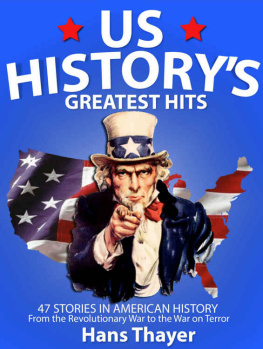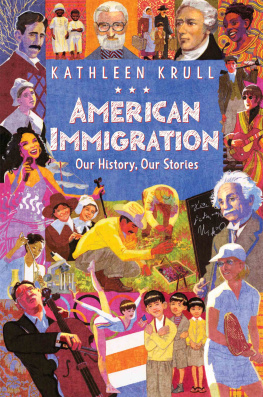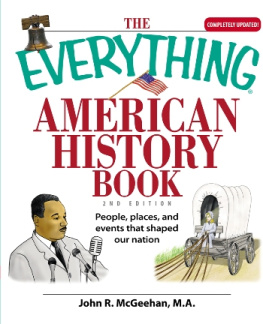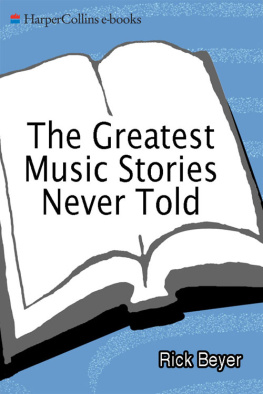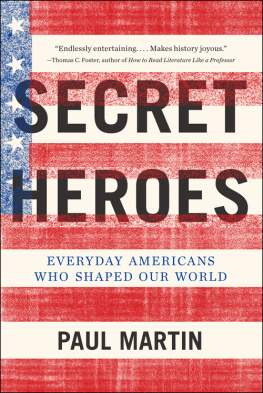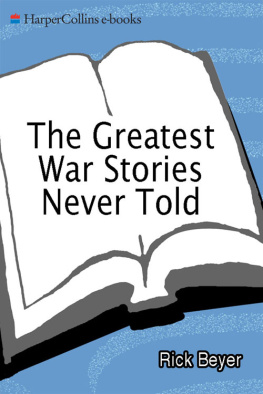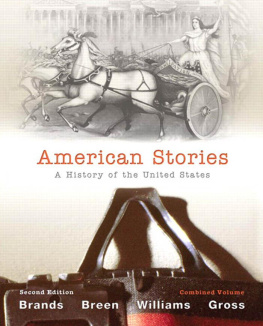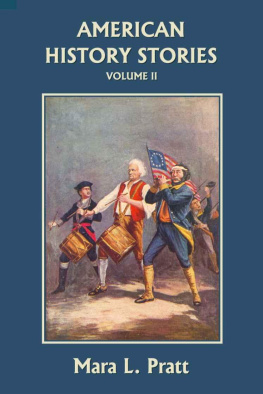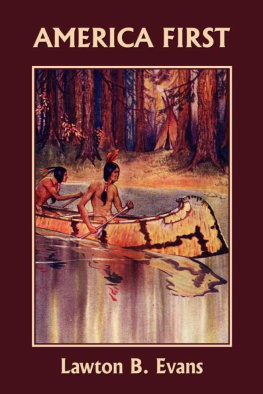US Historys Greatest Hits: 47 Stories in American History
Hans Thayer
Copyright 2016 by Deep Sea Publishing
ISBN-13: 978-1530155385
ISBN-10: 153015538X
All rights reserved. This book or any portion thereof may not be reproduced or used in any manner whatsoever without the express written permission of the publisher except for the use of brief quotations in a book review.
Introduction
The history of the United States is the unlikely story of a rag-tag group of rebels with little military training and even less money, armed with nearly nothing but a belief in freedom and liberty, who, against all odds, fought the greatest superpower in the world
and won!
Between the pages of US history books, there are stories of rebels, thieves, spies, innovators, adventurers, cannibals, heroes, lovers, and villains, but US history is too often beaten over the heads of unsuspecting students as a series of facts, dates, and events, which, without careful organization appear to have nothing to do with each other.
When I set out to write US Historys Greatest Hits, I wanted to find the best stories that make up American history; the kind of story you can tell at a party, barbecue, or campfire; stories long enough to connect with the emotion and drama, but short enough to keep your captive audience listening before they saunter off to the hors doeuvre tray.
I wanted to bring US History out of the classroom and into the daily lives of Americans.
When selecting these stories, I wanted to include stories that shaped American government and politics, but also the stories that reflect the daily lives of Americans in that time.
While this is a book designed mainly for entertainment, I have made every attempt at maintaining historical accuracy. Ive also made every attempt at curbing any bias I may have while selecting, writing, and editing these stories.
While it is always tricky to choose the greatest hits of a country with a history as rich and detailed history as the United States, Ive attempted to include both the stories that American students remember and love as well as lesser-known stories that are fascinating in their own rite.
Who is this book for?
Perhaps, like me, youre a former student wanting to reminisce on the main events of history class and wish to revisit them.
Perhaps, you are a current student who is learning history for the first time and you simply want to know what happened.
Perhaps, you are someone who has never learned the history of the United States and youre looking to read a few good stories and learn something while doing it.
Whoever you are and whatever your reasons, welcome to US Historys Greatest Hits. I hope you enjoy the stories of the incredible country known as the United States of America.
1770
The Start of a Revolution: The Boston Massacre
It was spring 1770. The fledgling American colonies were beginning to grow and thrive, establishing businesses, governments, and townships. But, colonies in America were beginning to grow tired of British rule; they refused to pay taxes, and fought with British soldiers in the streets. Britain was losing control. To demonstrate their power and ability to tax the colonies, the British government imposed an insulting tax law called the Townshend Acts. But little did they know, this imposition would spark the fire of the American Revolution.
Because the colonies were rejecting the Townshend Acts, the British increased security by sending more British soldiers to occupy the city of Boston.
Tension in the city was growing. British soldiers were being attacked in the streets and colonists were publicly harassed by British soldiers. The tension mounted when British soldiers, looking for part-time work, started to brawl with colonists working on the docks.
After a day of brawling, both parties paused the fight because the next two days were religious holidays. But tempers were still flaring when the holiday ended on Monday and colonists rallied in the streets in front of the British Customs House.
The colonists taunted and harangued the British sentinel on guard.
The Sentinel feared an attack and called for backup and seven more soldiers came to his aid. The colonists started throwing snowballs and stones at the British. The Redcoat captain ordered the soldiers to point their bayonets toward the colonists and the colonists dared the British to fire, pelting them with snow and debris.
Pushed in the fray, one British soldier fell to the ground, accidentally discharging his rifle into the raucous crowd. Thinking a battle had begun, the other soldiers beside him began firing too.
The street quickly filled with gunpowder and smoke while the unarmed colonists fled for their lives. After the smoke and gunpowder cleared, the colonists were gone, leaving five colonists dead and three injured, including Crispus Attucks an African-American man who is said to be the first to go down.
News of the massacre spread like wildfire. But, it may have been an isolated incident if it werent for Paul Revere (the same patriot that later embarked on the Midnight Ride) who drew and distributed a political cartoon of British soldiers brutally slaughtering innocent colonists in the event he labeled The Bloody Massacre.
Whether or not both sides were culpable, the incident inspired the colonies to rise up and demand the end of British rule, which led to the Revolutionary War and the great country we know today as the United States of America.
1773
The Boston Tea Party
By the winter of 1773, tensions between the American colonies and their British rulers were steadily rising. Americans had already begun to resist the taxation imposed by the Townshend Acts, resulting in the bloody Boston Massacre of 1770. In May, 1773, British parliament granted a monopoly to the East India Company on all tea being imported into the colonies. Duties on this tea were cheaper than ever before, yet in agreeing to pay these duties, the colonies would be tacitly consenting to taxation without representation. When three East India Company ships sailed into Boston Harbor that November, the resulting incident, popularly known as The Boston Tea Party, pushed the volatile relationship between England and America to its breaking point.
Meetings were held upon the arrival of the East India Company ships. Samuel Adams, one of Americas founding fathers, organized a great meeting to discuss what to do about the ships on December 16, 1773. In the meeting, it was agreed that the ships should be sent back to Britain with the duty unpaid.
When this proposal was presented at the Boston Customs House, it was rejected. The customs official insisted that the duty on tea be paid. The assembled colonists would not accept this verdict and their retaliation was swift and direct.
Roughly two hundred men dressed as Native Americans marched on Griffins Wharf, and divided themselves amongst the three docked ships. Using tomahawks, they cut open the chests of tea and dumped them into the bay until every last remnant of the improperly-taxed tea had been disposed of. Crews on smaller boats returned the next morning to ensure that any remaining bits of tea still floating in the bay were ruined as well.
The message to Britain was loud and clear: the colonials would rather destroy the tea than be taxed by the British. Though effectively non-violent in execution, the complete rejection of British authority was an important indication of how dire the tension in America had become. The Tea Party was used as a rallying cry by Samuel Adams and others to continue to stand up to the British.
Next page
